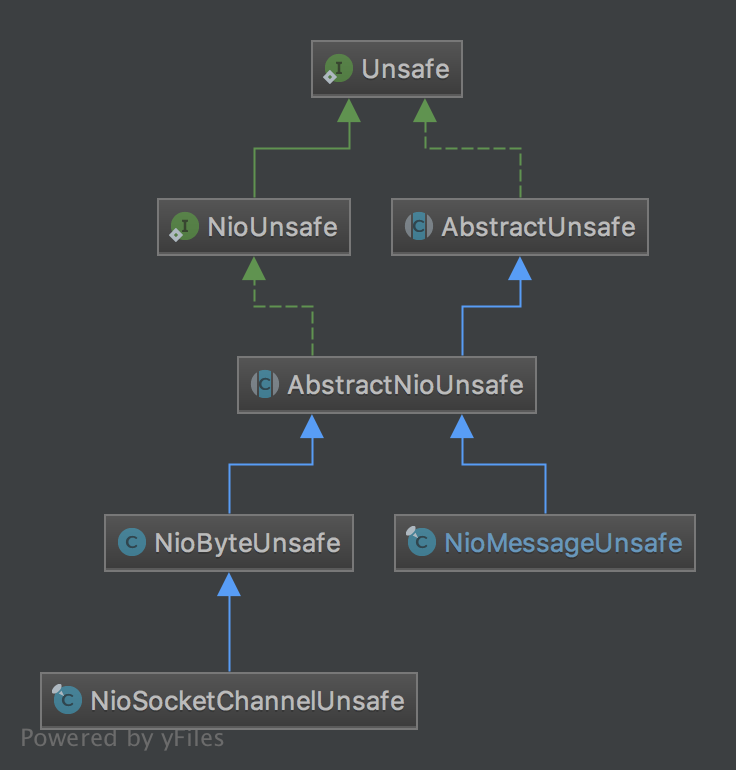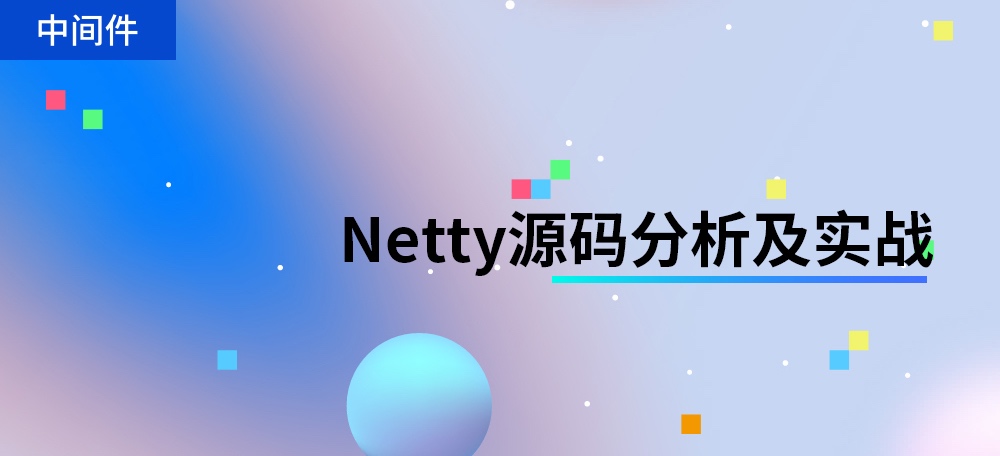前言
netty源码分析之pipeline(一)中,我们已经了解了pipeline在netty中所处的角色,像是一条流水线,控制着字节流的读写,本文,我们在这个基础上继续深挖pipeline在事件传播,异常传播等方面的细节
主要内容
接下来,本文分以下几个部分进行
- netty中的Unsafe到底是干什么的
- pipeline中的head
- pipeline中的inBound事件传播
- pipeline中的tail
- pipeline中的outBound事件传播
- pipeline 中异常的传播
Unsafe到底是干什么的
之所以Unsafe放到pipeline中讲,是因为unsafe和pipeline密切相关,pipeline中的有关io的操作最终都是落地到unsafe,所以,有必要先讲讲unsafe
初识Unsafe
顾名思义,unsafe是不安全的意思,就是告诉你不要在应用程序里面直接使用Unsafe以及他的衍生类对象。
netty官方的解释如下
Unsafe operations that should never be called from user-code. These methods are only provided to implement the actual transport, and must be invoked from an I/O thread
Unsafe 在Channel定义,属于Channel的内部类,表明Unsafe和Channel密切相关
下面是unsafe接口的所有方法
interface Unsafe {
RecvByteBufAllocator.Handle recvBufAllocHandle();
SocketAddress localAddress();
SocketAddress remoteAddress();
void register(EventLoop eventLoop, ChannelPromise promise);
void bind(SocketAddress localAddress, ChannelPromise promise);
void connect(SocketAddress remoteAddress, SocketAddress localAddress, ChannelPromise promise);
void disconnect(ChannelPromise promise);
void close(ChannelPromise promise);
void closeForcibly();
void beginRead();
void write(Object msg, ChannelPromise promise);
void flush();
ChannelPromise voidPromise();
ChannelOutboundBuffer outboundBuffer();
}
按功能可以分为分配内存,Socket四元组信息,注册事件循环,绑定网卡端口,Socket的连接和关闭,Socket的读写,看的出来,这些操作都是和jdk底层相关
Unsafe 继承结构

NioUnsafe 在 Unsafe基础上增加了以下几个接口
public interface NioUnsafe extends Unsafe {
SelectableChannel ch();
void finishConnect();
void read();
void forceFlush();
}
从增加的接口以及类名上来看,NioUnsafe 增加了可以访问底层jdk的SelectableChannel的功能,定义了从SelectableChannel读取数据的read方法
AbstractUnsafe 实现了大部分Unsafe的功能
AbstractNioUnsafe 主要是通过代理到其外部类AbstractNioChannel拿到了与jdk nio相关的一些信息,比如SelectableChannel,SelectionKey等等
NioSocketChannelUnsafe和NioByteUnsafe放到一起讲,其实现了IO的基本操作,读,和写,这些操作都与jdk底层相关
NioMessageUnsafe和 NioByteUnsafe 是处在同一层次的抽象,netty将一个新连接的建立也当作一个io操作来处理,这里的Message的含义我们可以当作是一个SelectableChannel,读的意思就是accept一个SelectableChannel,写的意思是针对一些无连接的协议,比如UDP来操作的,我们先不用关注
Unsafe的分类
从以上继承结构来看,我们可以总结出两种类型的Unsafe分类,一个是与连接的字节数据读写相关的NioByteUnsafe,一个是与新连接建立操作相关的NioMessageUnsafe
NioByteUnsafe中的读:委托到外部类NioSocketChannel
protected int doReadBytes(ByteBuf byteBuf) throws Exception {
final RecvByteBufAllocator.Handle allocHandle = unsafe().recvBufAllocHandle();
allocHandle.attemptedBytesRead(byteBuf.writableBytes());
return byteBuf.writeBytes(javaChannel(), allocHandle.attemptedBytesRead());
}
最后一行已经与jdk底层以及netty中的ByteBuf相关,将jdk的 SelectableChannel的字节数据读取到netty的ByteBuf中
NioMessageUnsafe中的读:委托到外部类NioSocketChannel
protected int doReadMessages(List<Object> buf) throws Exception {
SocketChannel ch = javaChannel().accept();
if (ch != null) {
buf.add(new NioSocketChannel(this, ch));
return 1;
}
return 0;
}
NioMessageUnsafe 的读操作很简单,就是调用jdk的accept()方法,新建立一条连接
NioByteUnsafe中的写:委托到外部类NioSocketChannel
@Override
protected int doWriteBytes(ByteBuf buf) throws Exception {
final int expectedWrittenBytes = buf.readableBytes();
return buf.readBytes(javaChannel(), expectedWrittenBytes);
}
最后一行已经与jdk底层以及netty中的ByteBuf相关,将netty的ByteBuf中的字节数据写到jdk的 SelectableChannel中
NioMessageUnsafe 的写,在tcp协议层面我们基本不会涉及,暂时忽略,udp协议的读者可以自己去研究一番~
关于Unsafe我们就先了解这么多
pipeline中的head
netty源码分析之pipeline(一)中,我们了解到head节点在pipeline中第一个处理IO事件,新连接接入和读事件在reactor线程的第二个步骤被检测到
NioEventLoop
private void processSelectedKey(SelectionKey k, AbstractNioChannel ch) {
final AbstractNioChannel.NioUnsafe unsafe = ch.unsafe();
//新连接的已准备接入或者已存在的连接有数据可读
if ((readyOps & (SelectionKey.OP_READ | SelectionKey.OP_ACCEPT)) != 0 || readyOps == 0) {
unsafe.read();
}
}
读操作直接依赖到unsafe来进行,新连接的接入在netty源码分析之新连接接入全解析中已详细阐述,这里不再描述,下面将重点放到连接字节数据流的读写
NioByteUnsafe
@Override
public final void read() {
final ChannelConfig config = config();
final ChannelPipeline pipeline = pipeline();
// 创建ByteBuf分配器
final ByteBufAllocator allocator = config.getAllocator();
final RecvByteBufAllocator.Handle allocHandle = recvBufAllocHandle();
allocHandle.reset(config);
ByteBuf byteBuf = null;
do {
// 分配一个ByteBuf
byteBuf = allocHandle.allocate(allocator);
// 将数据读取到分配的ByteBuf中去
allocHandle.lastBytesRead(doReadBytes(byteBuf));
if (allocHandle.lastBytesRead() <= 0) {
byteBuf.release();
byteBuf = null;
close = allocHandle.lastBytesRead() < 0;
break;
}
// 触发事件,将会引发pipeline的读事件传播
pipeline.fireChannelRead(byteBuf);
byteBuf = null;
} while (allocHandle.continueReading());
pipeline.fireChannelReadComplete();
}
同样,我抽出了核心代码,细枝末节先剪去,NioByteUnsafe 要做的事情可以简单地分为以下几个步骤
- 拿到Channel的config之后拿到ByteBuf分配器,用分配器来分配一个ByteBuf,ByteBuf是netty里面的字节数据载体,后面读取的数据都读到这个对象里面
- 将Channel中的数据读取到ByteBuf
- 数据读完之后,调用
pipeline.fireChannelRead(byteBuf);从head节点开始传播至整个pipeline
这里,我们的重点其实就是 pipeline.fireChannelRead(byteBuf);
DefaultChannelPipeline
final AbstractChannelHandlerContext head;
//...
head = new HeadContext(this);
public final ChannelPipeline fireChannelRead(Object msg) {
AbstractChannelHandlerContext.invokeChannelRead(head, msg);
return this;
}
结合这幅图


可以看到,数据从head节点开始流入,在进行下一步之前,我们先把head节点的功能过一遍
HeadContext
final class HeadContext extends AbstractChannelHandlerContext
implements ChannelOutboundHandler, ChannelInboundHandler {
private final Unsafe unsafe;
HeadContext(DefaultChannelPipeline pipeline) {
super(pipeline, null, HEAD_NAME, false, true);
unsafe = pipeline.channel().unsafe();
setAddComplete();
}
@Override
public ChannelHandler handler() {
return this;
}
@Override
public void handlerAdded(ChannelHandlerContext ctx) throws Exception {
// NOOP
}
@Override
public void handlerRemoved(ChannelHandlerContext ctx) throws Exception {
// NOOP
}
@Override
public void bind(
ChannelHandlerContext ctx, SocketAddress localAddress, ChannelPromise promise)
throws Exception {
unsafe.bind(localAddress, promise);
}
@Override
public void connect(
ChannelHandlerContext ctx,
SocketAddress remoteAddress, SocketAddress localAddress,
ChannelPromise promise) throws Exception {
unsafe.connect(remoteAddress, localAddress, promise);
}
@Override
public void disconnect(ChannelHandlerContext ctx, ChannelPromise promise) throws Exception {
unsafe.disconnect(promise);
}
@Override
public void close(ChannelHandlerContext ctx, ChannelPromise promise) throws Exception {
unsafe.close(promise);
}
@Override
public void deregister(ChannelHandlerContext ctx, ChannelPromise promise) throws Exception {
unsafe.deregister(promise);
}
@Override
public void read(ChannelHandlerContext ctx) {
unsafe.beginRead();
}
@Override
public void write(ChannelHandlerContext ctx, Object msg, ChannelPromise promise) throws Exception {
unsafe.write(msg, promise);
}
@Override
public void flush(ChannelHandlerContext ctx) throws Exception {
unsafe.flush();
}
@Override
public void exceptionCaught(ChannelHandlerContext ctx, Throwable cause) throws Exception {
ctx.fireExceptionCaught(cause);
}
@Override
public void channelRegistered(ChannelHandlerContext ctx) throws Exception {
invokeHandlerAddedIfNeeded();
ctx.fireChannelRegistered();
}
@Override
public void channelUnregistered(ChannelHandlerContext ctx) throws Exception {
ctx.fireChannelUnregistered();
// Remove all handlers sequentially if channel is closed and unregistered.
if (!channel.isOpen()) {
destroy();
}
}
@Override
public void channelActive(ChannelHandlerContext ctx) throws Exception {
ctx.fireChannelActive();
readIfIsAutoRead();
}
@Override
public void channelInactive(ChannelHandlerContext ctx) throws Exception {
ctx.fireChannelInactive();
}
@Override
public void channelRead(ChannelHandlerContext ctx, Object msg) throws Exception {
ctx.fireChannelRead(msg);
}
@Override
public void channelReadComplete(ChannelHandlerContext ctx) throws Exception {
ctx.fireChannelReadComplete();
readIfIsAutoRead();
}
private void readIfIsAutoRead() {
if (channel.config().isAutoRead()) {
channel.read();
}
}
@Override
public void userEventTriggered(ChannelHandlerContext ctx, Object evt) throws Exception {
ctx.fireUserEventTriggered(evt);
}
@Override
public void channelWritabilityChanged(ChannelHandlerContext ctx) throws Exception {
ctx.fireChannelWritabilityChanged();
}
}
从head节点继承的两个接口看,TA既是一个ChannelHandlerContext,同时又属于inBound(最新代码已经加上这一接口)和outBound Handler
在传播读写事件的时候,head的功能只是简单地将事件传播下去,如ctx.fireChannelRead(msg);
在真正执行读写操作的时候,例如在调用writeAndFlush()等方法的时候,最终都会委托到unsafe执行,而当一次数据读完,channelReadComplete方法首先被调用,TA要做的事情除了将事件继续传播下去之外,还得继续向reactor线程注册读事件,即调用readIfIsAutoRead(), 我们简单跟一下
HeadContext
private void readIfIsAutoRead() {
if (channel.config().isAutoRead()) {
channel.read();
}
}
AbstractChannel
@Override
public Channel read() {
pipeline.read();
return this;
}
默认情况下,Channel都是默认开启自动读取模式的,即只要Channel是active的,读完一波数据之后就继续向selector注册读事件,这样就可以连续不断得读取数据,最终,通过pipeline,还是传递到head节点
HeadContext
@Override
public void read(ChannelHandlerContext ctx) {
unsafe.beginRead();
}
委托到了 NioByteUnsafe
NioByteUnsafe
@Override
public final void beginRead() {
doBeginRead();
}
AbstractNioChannel
@Override
protected void doBeginRead() throws Exception {
// Channel.read() or ChannelHandlerContext.read() was called
final SelectionKey selectionKey = this.selectionKey;
if (!selectionKey.isValid()) {
return;
}
readPending = true;
final int interestOps = selectionKey.interestOps();
if ((interestOps & readInterestOp) == 0) {
selectionKey.interestOps(interestOps | readInterestOp);
}
}
doBeginRead() 做的事情很简单,拿到处理过的selectionKey,然后如果发现该selectionKey若在某个地方被移除了readInterestOp操作,这里给他加上,事实上,标准的netty程序是不会走到这一行的,只有在三次握手成功之后,如下方法被调用
public void channelActive(ChannelHandlerContext ctx) throws Exception {
ctx.fireChannelActive();
readIfIsAutoRead();
}
才会将readInterestOp注册到SelectionKey上,可结合 netty源码分析之新连接接入全解析 来看
总结一点,head节点的作用就是作为pipeline的头节点开始传递读写事件,调用unsafe进行实际的读写操作,下面,进入pipeline中非常重要的一环,inbound事件的传播
pipeline中的inBound事件传播
在 netty源码分析之新连接接入全解析 一文中,我们没有详细描述为啥pipeline.fireChannelActive();最终会调用到AbstractNioChannel.doBeginRead(),了解pipeline中的事件传播机制,你会发现相当简单
DefaultChannelPipeline
public final ChannelPipeline fireChannelActive() {
AbstractChannelHandlerContext.invokeChannelActive(head);
return this;
}
三次握手成功之后,pipeline.fireChannelActive();被调用,然后以head节点为参数,直接一个静态调用
AbstractChannelHandlerContext
static void invokeChannelActive(final AbstractChannelHandlerContext next) {
EventExecutor executor = next.executor();
if (executor.inEventLoop()) {
next.invokeChannelActive();
} else {
executor.execute(new Runnable() {
@Override
public void run() {
next.invokeChannelActive();
}
});
}
}
首先,netty为了确保线程的安全性,将确保该操作在reactor线程中被执行,这里直接调用 HeadContext.fireChannelActive()方法
HeadContext
public void channelActive(ChannelHandlerContext ctx) throws Exception {
ctx.fireChannelActive();
readIfIsAutoRead();
}
我们先看 ctx.fireChannelActive();,跟进去之前我们先看下当前pipeline的情况
[2.png]
AbstractChannelHandlerContext
public ChannelHandlerContext fireChannelActive() {
final AbstractChannelHandlerContext next = findContextInbound();
invokeChannelActive(next);
return this;
}
首先,调用 findContextInbound() 找到下一个inbound节点,由于当前pipeline的双向链表结构中既有inbound节点,又有outbound节点,让我们看看netty是怎么找到下一个inBound节点的
AbstractChannelHandlerContext
private AbstractChannelHandlerContext findContextInbound() {
AbstractChannelHandlerContext ctx = this;
do {
ctx = ctx.next;
} while (!ctx.inbound);
return ctx;
}
这段代码很清楚地表明,netty寻找下一个inBound节点的过程是一个线性搜索的过程,他会遍历双向链表的下一个节点,直到下一个节点为inBound(关于inBound和outBound,netty源码分析之pipeline(一)已有说明,这里不再详细分析)
找到下一个节点之后,执行 invokeChannelActive(next);,一个递归调用,直到最后一个inBound节点——tail节点
TailContext
@Override
public void channelActive(ChannelHandlerContext ctx) throws Exception { }
Tail节点的该方法为空,结束调用,同理,可以分析所有的inBound事件的传播,正常情况下,即用户如果不覆盖每个节点的事件传播操作,几乎所有的事件最后都落到tail节点,所以,我们有必要研究一下tail节点所具有的功能
pipeline中的tail
final class TailContext extends AbstractChannelHandlerContext implements ChannelInboundHandler {
TailContext(DefaultChannelPipeline pipeline) {
super(pipeline, null, TAIL_NAME, true, false);
setAddComplete();
}
@Override
public ChannelHandler handler() {
return this;
}
@Override
public void channelRegistered(ChannelHandlerContext ctx) throws Exception { }
@Override
public void channelUnregistered(ChannelHandlerContext ctx) throws Exception { }
@Override
public void channelActive(ChannelHandlerContext ctx) throws Exception { }
@Override
public void channelInactive(ChannelHandlerContext ctx) throws Exception { }
@Override
public void channelWritabilityChanged(ChannelHandlerContext ctx) throws Exception { }
@Override
public void handlerAdded(ChannelHandlerContext ctx) throws Exception { }
@Override
public void handlerRemoved(ChannelHandlerContext ctx) throws Exception { }
@Override
public void userEventTriggered(ChannelHandlerContext ctx, Object evt) throws Exception {
// This may not be a configuration error and so don't log anything.
// The event may be superfluous for the current pipeline configuration.
ReferenceCountUtil.release(evt);
}
@Override
public void exceptionCaught(ChannelHandlerContext ctx, Throwable cause) throws Exception {
onUnhandledInboundException(cause);
}
@Override
public void channelRead(ChannelHandlerContext ctx, Object msg) throws Exception {
onUnhandledInboundMessage(msg);
}
@Override
public void channelReadComplete(ChannelHandlerContext ctx) throws Exception { }
}
正如我们前面所提到的,tail节点的大部分作用即终止事件的传播(方法体为空),除此之外,有两个重要的方法我们必须提一下,exceptionCaught()和channelRead()
exceptionCaught
protected void onUnhandledInboundException(Throwable cause) {
try {
logger.warn(
"An exceptionCaught() event was fired, and it reached at the tail of the pipeline. " +
"It usually means the last handler in the pipeline did not handle the exception.",
cause);
} finally {
ReferenceCountUtil.release(cause);
}
}
异常传播的机制和inBound事件传播的机制一样,最终如果用户自定义节点没有处理的话,会落到tail节点,tail节点可不会简单地吞下这个异常,而是向你发出警告,相信使用netty的同学对这段警告不陌生吧?
channelRead
protected void onUnhandledInboundMessage(Object msg) {
try {
logger.debug(
"Discarded inbound message {} that reached at the tail of the pipeline. " +
"Please check your pipeline configuration.", msg);
} finally {
ReferenceCountUtil.release(msg);
}
}
另外,tail节点在发现字节数据(ByteBuf)或者decoder之后的业务对象在pipeline流转过程中没有被消费,落到tail节点,tail节点就会给你发出一个警告,告诉你,我已经将你未处理的数据给丢掉了
总结一下,tail节点的作用就是结束事件传播,并且对一些重要的事件做一些善意提醒
pipeline中的outBound事件传播
上一节中,我们在阐述tail节点的功能时,忽略了其父类AbstractChannelHandlerContext所具有的功能,这一节中,我们以最常见的writeAndFlush操作来看下pipeline中的outBound事件是如何向外传播的
典型的消息推送系统中,会有类似下面的一段代码
Channel channel = getChannel(userInfo);
channel.writeAndFlush(pushInfo);
这段代码的含义就是根据用户信息拿到对应的Channel,然后给用户推送消息,跟进 channel.writeAndFlush
NioSocketChannel
public ChannelFuture writeAndFlush(Object msg) {
return pipeline.writeAndFlush(msg);
}
从pipeline开始往外传播
public final ChannelFuture writeAndFlush(Object msg) {
return tail.writeAndFlush(msg);
}
Channel 中大部分outBound事件都是从tail开始往外传播, writeAndFlush()方法是tail继承而来的方法,我们跟进去
AbstractChannelHandlerContext
public ChannelFuture writeAndFlush(Object msg) {
return writeAndFlush(msg, newPromise());
}
public ChannelFuture writeAndFlush(Object msg, ChannelPromise promise) {
write(msg, true, promise);
return promise;
}
这里提前说一点,netty中很多io操作都是异步操作,返回一个ChannelFuture给调用方,调用方拿到这个future可以在适当的时机拿到操作的结果,或者注册回调,后面的源码系列会深挖,这里就带过了,我们继续
AbstractChannelHandlerContext
private void write(Object msg, boolean flush, ChannelPromise promise) {
AbstractChannelHandlerContext next = findContextOutbound();
final Object m = pipeline.touch(msg, next);
EventExecutor executor = next.executor();
if (executor.inEventLoop()) {
if (flush) {
next.invokeWriteAndFlush(m, promise);
} else {
next.invokeWrite(m, promise);
}
} else {
AbstractWriteTask task;
if (flush) {
task = WriteAndFlushTask.newInstance(next, m, promise);
} else {
task = WriteTask.newInstance(next, m, promise);
}
safeExecute(executor, task, promise, m);
}
}
netty为了保证程序的高效执行,所有的核心的操作都在reactor线程中处理,如果业务线程调用Channel的读写方法,netty会将该操作封装成一个task,随后在reactor线程中执行,参考 netty源码分析之揭开reactor线程的面纱(三),异步task的执行
这里我们为了不跑偏,假设是在reactor线程中(上面的这段例子其实是在业务线程中),先调用findContextOutbound()方法找到下一个outBound()节点
AbstractChannelHandlerContext
private AbstractChannelHandlerContext findContextOutbound() {
AbstractChannelHandlerContext ctx = this;
do {
ctx = ctx.prev;
} while (!ctx.outbound);
return ctx;
}
找outBound节点的过程和找inBound节点类似,反方向遍历pipeline中的双向链表,直到第一个outBound节点next,然后调用next.invokeWriteAndFlush(m, promise)
AbstractChannelHandlerContext
private void invokeWriteAndFlush(Object msg, ChannelPromise promise) {
if (invokeHandler()) {
invokeWrite0(msg, promise);
invokeFlush0();
} else {
writeAndFlush(msg, promise);
}
}
调用该节点的ChannelHandler的write方法,flush方法我们暂且忽略,后面会专门讲writeAndFlush的完整流程
AbstractChannelHandlerContext
private void invokeWrite0(Object msg, ChannelPromise promise) {
try {
((ChannelOutboundHandler) handler()).write(this, msg, promise);
} catch (Throwable t) {
notifyOutboundHandlerException(t, promise);
}
}
我们在使用outBound类型的ChannelHandler中,一般会继承 ChannelOutboundHandlerAdapter,所以,我们需要看看他的 write方法是怎么处理outBound事件传播的
ChannelOutboundHandlerAdapter
public void write(ChannelHandlerContext ctx, Object msg, ChannelPromise promise) throws Exception {
ctx.write(msg, promise);
}
很简单,他除了递归调用 ctx.write(msg, promise);之外,啥事也没干,在netty源码分析之pipeline(一)我们已经知道,pipeline的双向链表结构中,最后一个outBound节点是head节点,因此数据最终会落地到TA的write方法
HeadContext
public void write(ChannelHandlerContext ctx, Object msg, ChannelPromise promise) throws Exception {
unsafe.write(msg, promise);
}
这里,加深了我们对head节点的理解,即所有的数据写出都会经过head节点,我们在下一节会深挖,这里暂且到此为止
实际情况下,outBound类的节点中会有一种特殊类型的节点叫encoder,它的作用是根据自定义编码规则将业务对象转换成ByteBuf,而这类encoder 一般继承自 MessageToByteEncoder
下面是一段
public abstract class DataPacketEncoder extends MessageToByteEncoder<DatePacket> {
@Override
protected void encode(ChannelHandlerContext ctx, DatePacket msg, ByteBuf out) throws Exception {
// 这里拿到业务对象msg的数据,然后调用 out.writeXXX()系列方法编码
}
}
为什么业务代码只需要覆盖这里的encod方法,就可以将业务对象转换成字节流写出去呢?通过前面的调用链条,我们需要查看一下其父类MessageToByteEncoder的write方法是怎么处理业务对象的
MessageToByteEncoder
public void write(ChannelHandlerContext ctx, Object msg, ChannelPromise promise) throws Exception {
ByteBuf buf = null;
try {
// 需要判断当前编码器能否处理这类对象
if (acceptOutboundMessage(msg)) {
I cast = (I) msg;
// 分配内存
buf = allocateBuffer(ctx, cast, preferDirect);
try {
encode(ctx, cast, buf);
} finally {
ReferenceCountUtil.release(cast);
}
// buf到这里已经装载着数据,于是把该buf往前丢,知道head节点
if (buf.isReadable()) {
ctx.write(buf, promise);
} else {
buf.release();
ctx.write(Unpooled.EMPTY_BUFFER, promise);
}
buf = null;
} else {
// 如果不能处理,就将outBound事件继续往前面传播
ctx.write(msg, promise);
}
} catch (EncoderException e) {
throw e;
} catch (Throwable e) {
throw new EncoderException(e);
} finally {
if (buf != null) {
buf.release();
}
}
先调用 acceptOutboundMessage 方法判断,该encoder是否可以处理msg对应的类的对象(暂不展开),通过之后,就强制转换,这里的泛型I对应的是DataPacket,转换之后,先开辟一段内存,调用encode(),即回到DataPacketEncoder中,将buf装满数据,最后,如果buf中被写了数据(buf.isReadable()),就将该buf往前丢,一直传递到head节点,被head节点的unsafe消费掉
当然,如果当前encoder不能处理当前业务对象,就简单地将该业务对象向前传播,直到head节点,最后,都处理完之后,释放buf,避免堆外内存泄漏
pipeline 中异常的传播
我们通常在业务代码中,会加入一个异常处理器,统一处理pipeline过程中的所有的异常,并且,一般该异常处理器需要加载自定义节点的最末尾,即

此类ExceptionHandler一般继承自 ChannelDuplexHandler,标识该节点既是一个inBound节点又是一个outBound节点,我们分别分析一下inBound事件和outBound事件过程中,ExceptionHandler是如何才处理这些异常的
inBound异常的处理
我们以数据的读取为例,看下netty是如何传播在这个过程中发生的异常
我们前面已经知道,对于每一个节点的数据读取都会调用AbstractChannelHandlerContext.invokeChannelRead()方法
AbstractChannelHandlerContext
private void invokeChannelRead(Object msg) {
try {
((ChannelInboundHandler) handler()).channelRead(this, msg);
} catch (Throwable t) {
notifyHandlerException(t);
}
}
可以看到该节点最终委托到其内部的ChannelHandler处理channelRead,而在最外层catch整个Throwable,因此,我们在如下用户代码中的异常会被捕获
public class BusinessHandler extends ChannelInboundHandlerAdapter {
@Override
protected void channelRead(ChannelHandlerContext ctx, Object data) throws Exception {
//...
throw new BusinessException(...);
//...
}
}
上面这段业务代码中的 BusinessException 会被 BusinessHandler所在的节点捕获,进入到 notifyHandlerException(t);往下传播,我们看下它是如何传播的
AbstractChannelHandlerContext
private void notifyHandlerException(Throwable cause) {
// 略去了非关键代码,读者可自行分析
invokeExceptionCaught(cause);
}
private void invokeExceptionCaught(final Throwable cause) {
handler().exceptionCaught(this, cause);
}
可以看到,此Hander中异常优先由此Handelr中的exceptionCaught方法来处理,默认情况下,如果不覆写此Handler中的exceptionCaught方法,调用
ChannelInboundHandlerAdapter
public void exceptionCaught(ChannelHandlerContext ctx, Throwable cause)
throws Exception {
ctx.fireExceptionCaught(cause);
}
AbstractChannelHandlerContext
public ChannelHandlerContext fireExceptionCaught(final Throwable cause) {
invokeExceptionCaught(next, cause);
return this;
}
到了这里,已经很清楚了,如果我们在自定义Handler中没有处理异常,那么默认情况下该异常将一直传递下去,遍历每一个节点,直到最后一个自定义异常处理器ExceptionHandler来终结,收编异常
Exceptionhandler
public Exceptionhandler extends ChannelDuplexHandler {
@Override
public void exceptionCaught(ChannelHandlerContext ctx, Throwable cause)
throws Exception {
// 处理该异常,并终止异常的传播
}
}
到了这里,你应该知道为什么异常处理器要加在pipeline的最后了吧?
outBound异常的处理
然而对于outBound事件传播过程中所发生的异常,该Exceptionhandler照样能完美处理,为什么?
我们以前面提到的writeAndFlush方法为例,来看看outBound事件传播过程中的异常最后是如何落到Exceptionhandler中去的
前面我们知道,channel.writeAndFlush()方法最终也会调用到节点的 invokeFlush0()方法(write机制比较复杂,我们留到后面的文章中将)
AbstractChannelHandlerContext
private void invokeWriteAndFlush(Object msg, ChannelPromise promise) {
if (invokeHandler()) {
invokeWrite0(msg, promise);
invokeFlush0();
} else {
writeAndFlush(msg, promise);
}
}
private void invokeFlush0() {
try {
((ChannelOutboundHandler) handler()).flush(this);
} catch (Throwable t) {
notifyHandlerException(t);
}
}
而invokeFlush0()会委托其内部的ChannelHandler的flush方法,我们一般实现的即是ChannelHandler的flush方法
private void invokeFlush0() {
try {
((ChannelOutboundHandler) handler()).flush(this);
} catch (Throwable t) {
notifyHandlerException(t);
}
}
好,假设在当前节点在flush的过程中发生了异常,都会被 notifyHandlerException(t);捕获,该方法会和inBound事件传播过程中的异常传播方法一样,也是轮流找下一个异常处理器,而如果异常处理器在pipeline最后面的话,一定会被执行到,这就是为什么该异常处理器也能处理outBound异常的原因
关于为啥 ExceptionHandler 既能处理inBound,又能处理outBound类型的异常的原因,总结一点就是,在任何节点中发生的异常都会往下一个节点传递,最后终究会传递到异常处理器
总结
最后,老样子,我们做下总结
1.一个Channel对应一个Unsafe,Unsafe处理底层操作,NioServerSocketChannel对应NioMessageUnsafe, NioSocketChannel对应NioByteUnsafe
2.inBound事件从head节点传播到tail节点,outBound事件从tail节点传播到head节点
3.异常传播只会往后传播,而且不分inbound还是outbound节点,不像outBound事件一样会往前传播
如果你觉得看的不过瘾,想系统学习Netty原理,那么你一定不要错过我的Netty源码分析系列视频:https://coding.imooc.com/class/230.html



